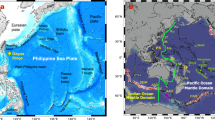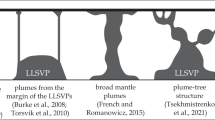Abstract
Isotope analyses of mid-ocean-ridge basalts have led to the identification of large-scale geochemical provinces, with a clear distinction between the Pacific and the Atlantic or Indian Ocean basins1,2. It is widely believed that Pacific ridges are formed from a single, fairly well mixed mantle reservoir3, extending from the Australian–Antarctic discordance to the Juan de Fuca ridge and representing one of the largest chemically coherent mantle domains on the Earth4,5. However, the evidence for this conception is mostly based on samples from the northern Pacific ridges. Here we report Sr, Nd and Pb isotope data from the Pacific Antarctic ridge that reveal different isotopic signatures north and south of the Easter microplate (25° S). The evidence for two large-scale geochemical domains is further strengthened by the observation of different average depths of the ridge axes north and south of the 25° S boundary. This boundary is located at the southeastern end of the Darwin rise/Pacific Superswell area6, which is interpreted as a zone of upwelling7 from the lower mantle that has persisted since Cretaceous times. We propose that this upwelling has led to the separation into two mantle domains with their own convective histories, producing slight differences in their average isotopic signatures and thermal regimes.
This is a preview of subscription content, access via your institution
Access options
Subscribe to this journal
Receive 51 print issues and online access
$199.00 per year
only $3.90 per issue
Buy this article
- Purchase on Springer Link
- Instant access to full article PDF
Prices may be subject to local taxes which are calculated during checkout



Similar content being viewed by others
References
Dupré, B. & Allègre, C. J. Pb-Sr isotope variation in Indian Ocean basalts and mixing phenomena. Nature 303, 142–143 ( 1983).
White, W. M., Hofmann, A. W. & Puchelt, H. Isotope geochemistry of Pacific mid-ocean ridge basalt. J. Geophys. Res. 92, 4881– 4893 (1987).
Cohen, R. S. & O'Nions, R. K. The lead, neodymium and strontium isotopic structure of ocean ridge basalts. J. Petrol. 23, 299–324 (1982).
Ferguson, E. M. & Klein, E. M. Fresh basalts from the Pacific Antarctic ridge extend the Pacific geochemical province. Nature 366, 330–333 (1993).
Klein, E. M., Langmuir, C. H., Zindler, A., Staudigel, H. & Hamelin, B. Isotope evidence of a mantle convection boundary at the Australian-Antarctic discordance. Nature 333, 623–629 (1988).
Davies, G. F. & Pribac, F. in The Mesozoic Pacific: Geology, Tectonic and Volcanism (eds Pringle, M. S. et al.) 39– 52 (Geophys. Monogr. 77, Am. Geophys. Un., Washington DC, ( 1993).
Castillo, P. The Dupal anomaly as a trace of the upwelling lower mantle. Nature 336, 667–670 ( 1988).
Castillo, P. R., Natland, J., Niu, Y. & Lonsdale, P. F. Sr, Nd and Pb isotopic variation along the Pacific-Antarctic risecrest, 53–57 degrees S: Implications for the composition and dynamics of the South Pacific upper mantle. Earth Planet. Sci. Lett. 154, 109 –125 (1998).
Macdougall, J. D. & Lugmair, G. W. Extreme isotopic homogeneity among basalts from the southern East Pacific Rise: mantle or mixing effect? Nature 313, 209– 211 (1985).
Macdougall, J. D. & Lugmair, G. W. Sr and Nd isotopes in basalts from the East Pacific Rise: significance for mantle heterogeneity. Earth Planet. Sci. Lett. 77, 273– 284 (1986).
Bach, W.et al. Unusually large Nb-Ta depletions in North Chile ridge basalts at 36 degrees 50′ to 38 degrees 56′ S: Major element, trace element, and isotopic data. Earth Planet. Sci. Lett. 142, 223–240 (1996).
Vlastélic, I. et al. Geochemistry of the Hollister Ridge: Relation with the Louisville hotspot and the Pacific-Antarctic Ridge. Earth Planet. Sci. Lett. 160, 777–793 (1998).
Klein, E. M. & Karsten, J. L. Ocean-ridge basalts with convergent-margin geochemical affinities from the Chile Ridge. Nature 374, 52–57 (1995).
Staudigel, H.et al. The longevity of the South Pacific isotopic and thermal anomaly. Earth Planet. Sci. Lett. 102, 24– 44 (1991).
McNutt, M. K. & Fisher, K. M. in Seamounts, Islands, and Atolls (eds Keating, B. H., Fryer, P., Batiza, R. & Boehlert, G. W.) 25–34 (Geophys. Monogr. 43, Am. Geophys. Un., Washington DC, (1987).
McNutt, M. K. & Judge, A. V. The superswell and mantle dynamics beneath the South Pacific. Science 248, 969–975 (1990).
McNutt, M. K., Winter, E. L., Sager, W. W., Natland, J. H. & Ito, J. The Darwin rise: a Cretaceous superswell. Geophys. Res. Lett. 17, 1101– 1104 (1990).
Hager, B. H., Clayton, R. W., Richards, M. A., Comer, R. P. & Dziewonski, A. M. Lower mantle heterogeneity, dynamic topography, and the geoid. Nature 313, 541–545 (1985).
Dziewonski, A. & Woodhouse, J. Global images of the Earth's interior. Science 236, 37 –48 (1987).
Tatsumi, Y., Shinjoe, H., Ishizuka, H., Sager, W. W. & Klaus, A. Geochemical evidence for a mid-Cretaceous superplume. Geology 26, 151– 154 (1998).
Chauvel, C., Hofmann, A. W. & Vidal, P. HIMU EM—The French Polynesian connection. Earth Planet. Sci. Lett. 110, 99–119 (1992).
Hémond, C. & Devey, C. W. The Foundation seamount chain, southeastern Pacific: first isotopic evidence of a newly discovered hotspot track. J. Conf. Abs. 1, 255 (1996).
Hanan, B. B. & Graham, D. W. Lead and helium isotope evidence from oceanic basalts for a common deep source of mantle plumes. Science 272, 991–995 ( 1996).
Zindler, A., Staudigel, H. & Batiza, R. Isotope and trace element geochemistry of young Pacific seamounts: implications for the scale of upper mantle heterogeneity. Earth Planet. Sci. Lett. 70, 175–195 (1984).
Hanson, G. N. Geochemical evolution of the suboceanic mantle. J. Geol. Soc. Lond. 134, 235–253 ( 1977).
Sleep, N. Tapping of magmas from ubiquitous mantle heterogeneities: an alternative to mantle plume? J. Geophys. Res. 89, 10029 –10041 (1984).
Klein, E. M. & Langmuir, C. H. Global correlations of ocean ridge basalt chemistry with axial depth and crustal thickness. J. Geophys. Res. 92, 8089–8115 (1987).
Smith, W. H. F. & Sandwell, D. T. Global sea floor topography from satellite altimetry and ship depth soundings. Science 277, 1956–1962 ( 1997).
Bach, W., Hegner, E., Erzinger, J. & Satir, M. Chemical and isotopic variations along the superfast spreading East Pacific Rise from 6 degrees S to 30 degrees S. Contrib. Mineral. Petrol. 116, 365–380 (1994).
Géli, L.et al . Evolution of the Pacific-Antarctic Ridge south of the Udintsev fracture zone. Science 278, 1281– 1284 (1997).
Londsdale, P. Geomorphology and structural segmentation of the crest of the Southern (Pacific-Antarctic) East Pacific Rise. J. Geophys. Res. 99, 4683–4702 (1994).
Acknowledgements
We thank C. Bollinger, and M. Bohn for their help in the laboratory, Captain G. Tredunit and the crew of RV L'Atalante for their efforts during the PACANTARCTIC cruise, and P.R.Castillo and B. Hanan for comments. This work was supported by Institut National des Sciences de l'Univers (INSU) and IFREMER.
Author information
Authors and Affiliations
Corresponding author
Supplementary Information
Rights and permissions
About this article
Cite this article
Vlastélic, I., Aslanian, D., Dosso, L. et al. Large-scale chemical and thermal division of the Pacific mantle. Nature 399, 345–350 (1999). https://doi.org/10.1038/20664
Received:
Accepted:
Issue Date:
DOI: https://doi.org/10.1038/20664
This article is cited by
-
Mantle sources and melting processes beneath East Antarctica: geochemical and isotopic (Sr, Nd, Pb, O) characteristics of alkaline and tholeiite basalt from the Earth’s southernmost (87° S) volcanoes
Contributions to Mineralogy and Petrology (2022)
-
An isotopically distinct Zealandia–Antarctic mantle domain in the Southern Ocean
Nature Geoscience (2019)
-
Geochemistry of southern Pagan Island lavas, Mariana arc: the role of subduction zone processes
Contributions to Mineralogy and Petrology (2011)
-
Geochemical tracing of Pacific-to-Atlantic upper-mantle flow through the Drake passage
Nature (2001)
Comments
By submitting a comment you agree to abide by our Terms and Community Guidelines. If you find something abusive or that does not comply with our terms or guidelines please flag it as inappropriate.



